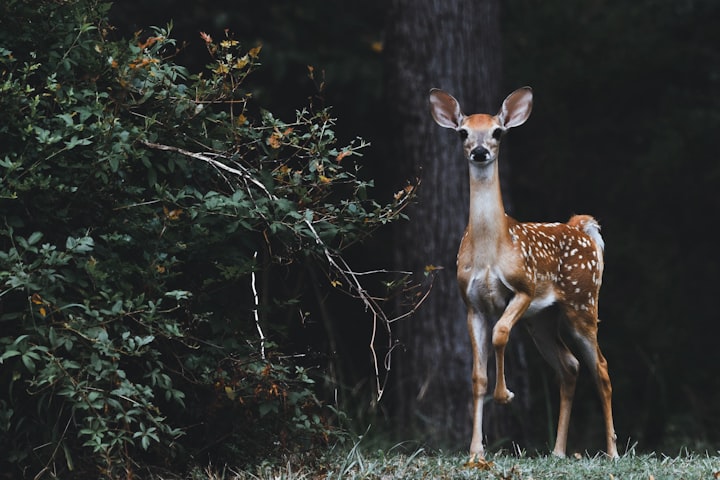According to the U.S.D.A., coronavirus likely spread widely among deer and may have returned to humans.
Coronavirus has been a major global health concern since its outbreak in 2019. While much of the focus has been on the transmission of the virus among humans,

Coronavirus has been a major global health concern since its outbreak in 2019. While much of the focus has been on the transmission of the virus among humans, recent research by the U.S. Department of Agriculture (U.S.D.A.) suggests that coronavirus may have also spread widely among deer populations. This discovery has raised significant implications for both wildlife and human health.
The Spread of Coronavirus Among Deer
According to the U.S.D.A., studies conducted in various parts of the country have found evidence of coronavirus infection among deer populations. The virus was detected through testing of nasal swabs and fecal samples collected from wild deer. The findings suggest that coronavirus has the potential to establish itself in deer populations, leading to a widespread transmission among these animals.
The exact mode of transmission among deer is still being investigated, but it is believed to be similar to the transmission among humans – through respiratory droplets and contact with contaminated surfaces. The close proximity of deer in herds and their interactions make them susceptible to the spread of the virus.
Implications for Humans
The discovery of coronavirus infection in deer has raised concerns about the potential for transmission back to humans. While there is currently no evidence of direct transmission from deer to humans, there is a possibility that it could happen.
Humans frequently come into contact with deer through activities such as hunting, wildlife observation, and farming. It is essential for individuals engaging in these activities to take precautions to minimize the risk of transmission. This includes practicing good hygiene, maintaining physical distance from wildlife, and properly cooking meat obtained from deer.
Further research is being conducted to better understand the implications of coronavirus infection in deer and its potential for transmission to humans. The U.S.D.A. is working closely with other organizations to monitor and mitigate the spread of the virus among wildlife and to ensure the safety of human populations.
For more information on coronavirus and its transmission among deer, you can refer to the U.S. Department of Agriculture website and other reputable sources.
II. Study by the U.S. Department of Agriculture (U.S.D.A.)
The U.S. Department of Agriculture (U.S.D.A.) has conducted a study exploring the spread of the coronavirus among deer populations and its potential implications for human transmission. The study aimed to understand the impact of the virus on wildlife and identify any risks to public health.
Overview of the U.S.D.A. Study on Deer and Coronavirus
The U.S.D.A. study focused on testing white-tailed deer populations in selected regions across the United States. The researchers collected samples from deer in areas known to have high rates of human infection. These samples were analyzed to determine if the virus was present in the deer population and to what extent.
The study employed advanced molecular techniques, such as polymerase chain reaction (PCR) testing, to detect the presence of the virus in deer samples. The U.S.D.A. collaborated with veterinarians, wildlife experts, and public health agencies to ensure comprehensive data collection and analysis.
Findings and Key Observations
The U.S.D.A. study yielded several interesting findings:
1. Widespread Infection: The study identified a significant prevalence of the coronavirus among deer populations in the study areas. This finding suggests that the virus has spread widely among wildlife.
2. Genetic Similarity: The genetic sequence of the virus found in deer closely resembled the strains observed in humans, indicating a possible transmission between the species.
3. Potential Source of Transmission: The presence of the virus in deer raises concerns about the potential for transmission back to humans. While further research is needed to fully understand the risks, it highlights the need for ongoing surveillance and monitoring of wildlife populations.
It is important to note that there is currently no evidence of direct transmission of the coronavirus from deer to humans. However, the study underscores the need for continued research and vigilance in tracking the spread of the virus among wildlife and its potential impact on public health.
III. Transmission Pathways and Interactions
How Coronavirus Can Spread Among Deer
According to the U.S.D.A., the coronavirus can spread widely among deer populations, which may have significant implications for both human health and wildlife conservation efforts. Deer are susceptible to certain coronaviruses, similar to those that affect humans, and can become infected through various pathways, such as:
1. Direct Contact: Deer can spread the virus through close contact with other infected individuals. This can occur through activities such as social grooming, mating, or fighting.
2. Environmental Exposure: Contaminated food, water, or surfaces can also serve as sources of transmission among deer populations. For instance, an infected deer shedding the virus in its saliva, feces, or urine may contaminate these resources, allowing other individuals to become infected.
3. Vector-Borne Transmission: In some cases, insects or ticks may act as intermediate hosts for the coronavirus, transferring the virus from infected deer to uninfected individuals. This mechanism of transmission is particularly concerning, as it introduces the potential for the virus to jump between species.
While further research is needed to fully understand the extent and dynamics of coronavirus transmission among deer, these findings highlight the importance of monitoring and managing wildlife populations to mitigate the risk of disease outbreaks.
Potential Routes of Transmission to Humans
The spread of coronavirus among deer raises concerns about the potential for spillover into human populations. While direct transmission from deer to humans is currently not well-documented, there are several pathways through which the virus could potentially be transmitted:
1. Hunting and Consumption: If humans come into contact with infected deer during hunting activities or consume contaminated meat, there is a possibility of contracting the virus. Proper handling and cooking of game meat are essential in reducing this risk.
2. Environmental Exposure: Individuals working or residing in areas with high deer populations, such as wildlife reserves or agricultural areas, may be at an increased risk of exposure to the virus. Precautions should be taken to minimize contact with potentially contaminated surfaces and wildlife excreta.
3. Vector-Borne Transmission: If the virus is transmitted to humans through vectors that feed on both deer and humans, such as ticks or mosquitos, there is a higher likelihood of spillover. Preventive measures such as using insect repellents and wearing protective clothing can help reduce the risk.
It is crucial to prioritize ongoing research and surveillance efforts to better understand the dynamics of coronavirus transmission among deer and its potential implications for human health. By proactively addressing these risks, we can better protect both wildlife and human populations.
IV. Human Health Risks
It is important to understand the potential impact of coronavirus transmission from deer to humans. While research is ongoing, the U.S.D.A. suggests that the coronavirus may have spread widely among deer populations and could potentially be transmitted back to humans who come into close contact with infected animals. Here are some key points to consider:
Potential Impact of Coronavirus Transmission from Deer to Humans
1. Zoonotic Infections: Zoonotic infections are diseases that can be transmitted between animals and humans. The coronavirus may be one such zoonotic infection, with deer serving as a potential reservoir for the virus.
2. Disease Transmission: Research suggests that coronaviruses can be transmitted through respiratory droplets, close contact, or contaminated surfaces. If deer are infected with the coronavirus, there is a possibility that humans who come into contact with infected animals, such as hunters or wildlife management professionals, could be at risk of contracting the virus.
3. Further Study: More research is needed to understand the exact mechanisms of coronavirus transmission between deer and humans. Scientists are working to determine the prevalence and potency of the virus in deer populations and its ability to cause illness in humans.
Precautionary Measures for Hunters and Wildlife Management
While the risk of coronavirus transmission from deer to humans is still being investigated, it is essential for hunters and wildlife management professionals to take precautionary measures to minimize potential exposure. Here are some recommended steps:
• Personal Protective Equipment: Hunters and wildlife management professionals should wear appropriate personal protective equipment, such as gloves, masks, and eye protection, when handling or processing deer.
• Hygiene Practices: Practicing good hygiene, such as washing hands thoroughly with soap and water before and after handling game, can help reduce the risk of infection.
• Proper Meat Handling and Processing: It is essential to handle and process game meat in a safe and sanitary manner, following recommended guidelines and procedures.
• Reporting Cases: If you suspect that a deer may be infected with the coronavirus, it is important to report it to the appropriate authorities or wildlife organizations for further investigation.
By taking these precautionary measures and staying informed about the latest research and guidelines, hunters and wildlife management professionals can minimize the potential risk of infection while continuing to enjoy outdoor activities and contribute to wildlife conservation efforts.
V. Future Research and Considerations
As the understanding of animal-human disease transmission continues to evolve, it is essential to prioritize monitoring and studying the spread of viruses among different species. The recent findings suggesting the likely spread of the coronavirus among deer and its potential return to humans highlight the need for further research and consideration. Here are a few key areas to focus on:
Importance of Monitoring and Understanding Animal-Human Disease Transmission
1. Early Detection: Early detection of potential zoonotic diseases is crucial for preventing outbreaks and minimizing the impact on both human and animal populations. Vigilant monitoring of wildlife and their interactions with humans can help identify and respond to emerging threats effectively.
2. Transmission Routes: Understanding the routes of disease transmission between animals and humans is essential for implementing appropriate preventive measures. This includes studying the modes of transmission, such as direct contact, respiratory droplets, or vector-borne transmission, and identifying potential intermediate hosts that facilitate the spread of diseases.
Implications for Public Health Policies and Wildlife Management Strategies
1. One Health Approach: The emerging evidence of animal-human disease transmission underscores the importance of the One Health approach, which recognizes the interconnections between human, animal, and environmental health. Integrating veterinary, wildlife, and human health expertise can enhance disease surveillance, prevention, and control efforts.
2. Wildlife Management and Conservation: The findings also have implications for wildlife management and conservation strategies. Balancing the preservation of biodiversity with the need to prevent disease transmission requires collaborative efforts between conservationists, wildlife managers, and public health professionals to develop sustainable approaches that protect both wildlife and human populations.
Continued research in these areas will contribute to a more comprehensive understanding of animal-human disease dynamics and help guide public health policies and wildlife management strategies. By proactively monitoring and studying infectious diseases, we can better prepare for future outbreaks and mitigate the risks to human and animal health.






Comments
There are no comments for this story
Be the first to respond and start the conversation.